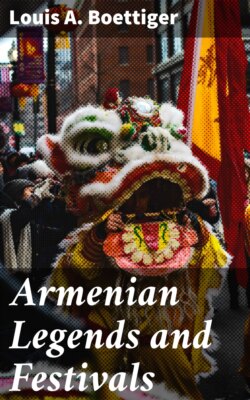Читать книгу Armenian Legends and Festivals - Louis A. Boettiger - Страница 11
На сайте Литреса книга снята с продажи.
Section 4. The Legend of Vahakn
ОглавлениеTable of Contents
The legend of Vahakn, king and god of Armenians, is very clearly attributable to the Greek period, which followed the Persian conquest under Xerxes. Vahakn was deified because of his great valor and made the fire-god of the Armenian people.16 He was called “Vishapakagh,” uprooter of dragons, since he cleared Armenia of monsters and saved it from evil influences. His exploits were known in the abode of the gods as well as in Armenia. The most famous of them was the theft of corn from the barns of King Barsham of Assyria, from whom he ran away and tried to hide in heaven. Because of the ears he dropped in his rapid flight, there arose the Milky Way which is called in Armenian the “track of the corn stealer.”17
Moses of Khorene writes as follows:
Concerning the birth of this king the legends say,
“Heaven and earth were in travail,
And the crimson waters were in travail,
And in the water, the crimson reed
Was also in travail.
From the mouth of the reed issued smoke,
From the mouth of the reed issued flame,
And out of the flame sprang the young child,
His hair was of fire, a beard had he of flame,
And his eyes were suns.”18
With our own ears did we hear these words sung to the accompaniment of the harp. They sing moreover that he did fight with the dragons, and overcame them; and some say that his valiant deeds were like unto Hercules. Others declare that he was a god, and that a great image of him stood in the land of Georgia, where it was worshipped, with sacrifices.19
The wife of Vahakn was Astghik, the goddess of beauty, a personification of the moon, corresponding to the Phoenician and Sidonian Astarte. This is suggestive of Greek influence, for Venus, the Greek goddess of beauty, was also the wife of a fire-god, Vulcan.20
The flight of Vahakn before the Assyrian king is certainly more suggestive of the fear in which the Assyrians must have been regarded than of the valor of their god. The originators of the legend were good psychologists, however, in regarding the instincts of fear and of pugnacity as compatible. For even the slayer of demons must some day face his superiors in strength, and when he does, will he not be afraid? In fact he would be more afraid than another, for he could not well impute more mercy to his superior than he himself had shown to his inferiors.
The vein of humor is too rich to be left unnoted. If the Greeks could laugh at their gods, and even mock them, the Armenians could also make sport of them. For what could be more delightfully humorous than the picture of a bearded god, a slayer of dragons, whose hair was of flame and whose eyes like suns, stealing corn from the Assyrian king and dropping the ears from his shoulders in his hasty flight across heaven? The character thus brought out, together with the richness of imaginative quality, especially in the song of his birth, the wholesome and unveiled anthropomorphism (wholesome because it is unveiled), and the correspondence between the Greek fire-god Vulcan whose wife was Venus, the goddess of beauty, with the fire-god Vahakn whose wife Astghik was also goddess of beauty, stamp the legend with its unmistakable origin in Greek mythology.
